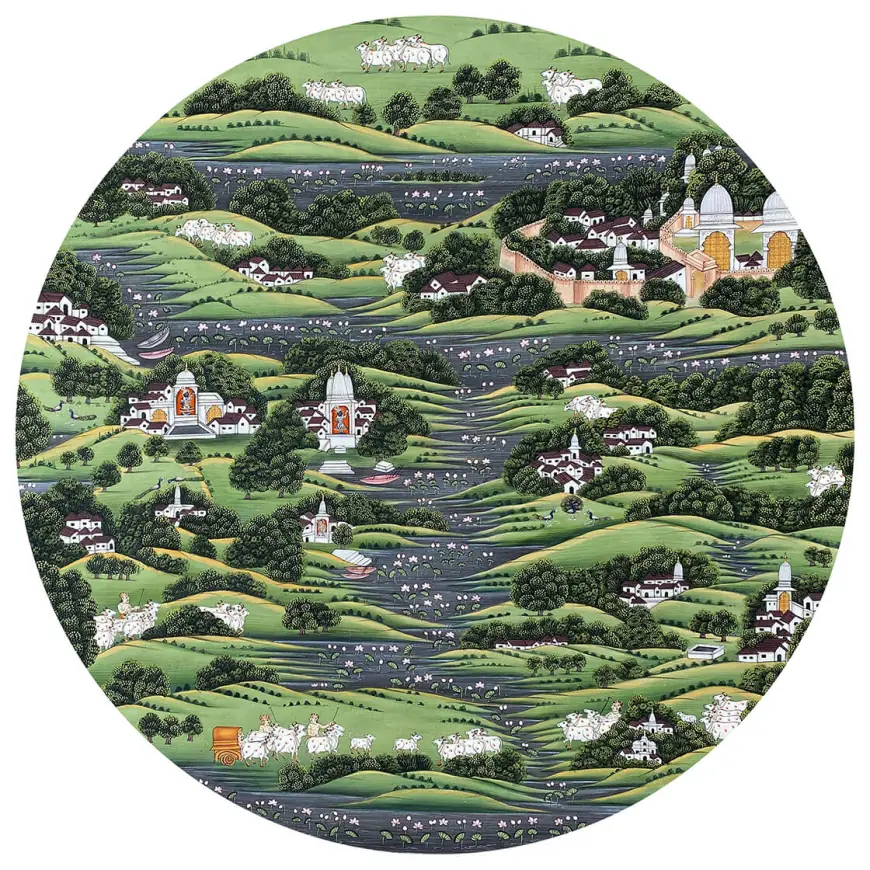Mughal Miniature Art: A Legacy of Elegance, Detail, and Royal Splendor
The convergence of Pichwai painting and Mughal Miniature Art marks a graceful evolution in Indian devotional aesthetics. While Pichwai art reflects the spiritual narratives of Lord Shrinathji, the inclusion of Mughal elements introduces a refined visual sophistication. Intricate floral borders, delicate textiles, and architectural motifs now enhance these sacred artworks, adding layers of richness without compromising their devotional core. Pioneers like Pichwai Art by Pooja Singhal and collectives such as Pichwai Tradition & Beyond have championed this blend, reimagining tradition for modern audiences. The result is a timeless fusion where sacred storytelling meets royal artistry, inviting deeper engagement from both art lovers and devotees.

A Timeless Union of Devotion and Royal Aesthetics
Pichwai painting, rooted in the temple town of Nathdwara, Rajasthan, has long served as a visual expression of devotion to Lord Shrinathji — an incarnation of Krishna. Traditionally painted on cloth and hung behind the deity, Pichwais convey religious stories and seasonal festivals. In recent years, a beautiful intersection has emerged between these sacred artworks and Mughal Miniature Art, creating a powerful synergy of spiritual depth and refined aesthetics.

What is Mughal Miniature Art?
Originating in the royal courts of the Mughal emperors, Mughal Miniature Art is celebrated for its intricate details, rich colors, and delicate portrayal of flora, fauna, and human emotion. These paintings often depicted court scenes, royal portraits, and epic narratives, blending Persian finesse with Indian themes. Their emphasis on symmetrical design and decorative flourishes has made them a natural complement to Pichwai compositions, which also prioritize precision and symbolism.
Bridging Two Traditions
The merging of Mughal Miniature Art into Pichwai was pioneered by modern ateliers such as Pichwai Tradition & Beyond (PTB). This innovation began when the curator was deconstructing the “Chowbees Swaroop” — 24 sacred forms of Shrinathji often painted around the borders of Pichwais. When isolated, these boxed depictions felt static. By incorporating Mughal-style decorative elements — such as ornate textiles, architectural arches, and garden-like settings — artists were able to breathe new life into these compositions.
Pichwai Art by Pooja Singhal: A Contemporary Vision
A notable name in this revival is Pichwai Art by Pooja Singhal, which reinterprets traditional themes with modern visual language. Her work maintains the devotional essence of Pichwai while embracing the lush elegance of Mughal Miniature Art. The result is a body of work that appeals not only to spiritual seekers but also to art collectors and historians fascinated by India’s rich visual heritage.

Aesthetic Transformation Through Mughal Influence
The infusion of Mughal Miniature Art has redefined the way Pichwai is perceived and practiced. Elements like the deity’s garments, floral borders, and background settings now exhibit a Mughal-inspired intricacy. Scenes like Annakut, Gopashtami, and Sharad Purnima appear more dynamic, infused with the symmetry and detail reminiscent of Mughal ateliers.
What's Your Reaction?
 Like
0
Like
0
 Dislike
0
Dislike
0
 Love
0
Love
0
 Funny
0
Funny
0
 Angry
0
Angry
0
 Sad
0
Sad
0
 Wow
0
Wow
0


















































